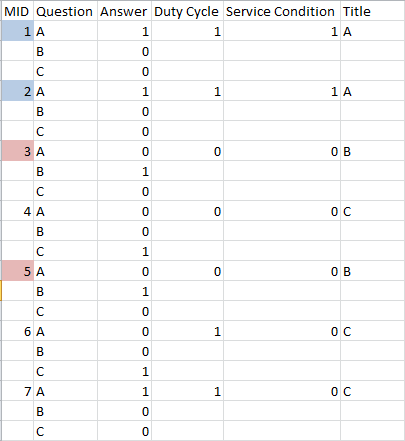Unlock a world of possibilities! Login now and discover the exclusive benefits awaiting you.
- Qlik Community
- :
- All Forums
- :
- QlikView App Dev
- :
- Creating Groups of data
- Subscribe to RSS Feed
- Mark Topic as New
- Mark Topic as Read
- Float this Topic for Current User
- Bookmark
- Subscribe
- Mute
- Printer Friendly Page
- Mark as New
- Bookmark
- Subscribe
- Mute
- Subscribe to RSS Feed
- Permalink
- Report Inappropriate Content
Creating Groups of data
I have some data that looks like this:

"MID" is a component. "Duty Cycle", "Service Condition", and "Title" are characteristics that describe each "MID". Questions "A", "B", and "C" are asked for each "MID", and each question has an answer.
What I need to do is group all the "MID"s that have the same "Duty Cycle", "Service Condition", "Title", and "Answers" so that I can call upon those groups to see things like how many "MID"s are in each group. In the example above, I highlighted the "MID"s that would be grouped together in this example. 1 would group with 2, 3 would group with 5, and 4, 6, and 7 would be in their own groups.
I was thinking the best way to do this was write a code that would create a new column and assign numbers to each "MID", and wherever the code came across a set of "Answer"s, "Duty Cycle"s, and "Service Condition"s that have already been read, it would assign the same number to that "MID"... Can somebody show me how to do what I suggested, or show me a better way to get what I need?
Thanks.
- Mark as New
- Bookmark
- Subscribe
- Mute
- Subscribe to RSS Feed
- Permalink
- Report Inappropriate Content
Something like this:
LOAD
MID,
Question,
Answer,
[Duty Cycle],
[Service Condition],
Title,
AutoNumber( MID & '|' & Answer & '|' & [Duty Cycle] & '|' & [Service Condition] & '|' & Title) as GroupID
FROM
...
;
talk is cheap, supply exceeds demand
- Mark as New
- Bookmark
- Subscribe
- Mute
- Subscribe to RSS Feed
- Permalink
- Report Inappropriate Content
I think this will help, but there are two things that might be a problem.
First, I need the groups to be dependent on the "Answer"s to the "Question"s also, not just "Duty Cycle", "Service Condition", and "Title".
Second, I am using a SQL load to pull this data from a database, and these fields are not all from the same table. "MID", "Duty Cycle", and "Service Condition" are from "Table 1". "Question" and "Answer" are from "Table 2". "Title" is from "Table 3".
Would it be best to concatenate the "Question" and "Answer" fields so I can include it in my autonumber function? If so, where should the concatenate function and the autonumber function go with respect to the SQL load?
- Mark as New
- Bookmark
- Subscribe
- Mute
- Subscribe to RSS Feed
- Permalink
- Report Inappropriate Content
can you post sample data with each table in separate tabs! and a tab to show expected output!
It's easier to comprehend than to read and visualise.
If a post helps to resolve your issue, please accept it as a Solution.
- Mark as New
- Bookmark
- Subscribe
- Mute
- Subscribe to RSS Feed
- Permalink
- Report Inappropriate Content
The "New Identifier" column in the last sheet is how I want the data to be grouped.
- Mark as New
- Bookmark
- Subscribe
- Mute
- Subscribe to RSS Feed
- Permalink
- Report Inappropriate Content
I made some changes to my data when I created this post in hopes of making it simpler. I still need the "MID"s to be grouped with other "MID"s that have the same "Service Condition", "Duty Cycle", "Title", and "Answer"s to each "Question".
- Mark as New
- Bookmark
- Subscribe
- Mute
- Subscribe to RSS Feed
- Permalink
- Report Inappropriate Content
Check the Attached
Map_TemplateID:
Mapping LOAD
[Template ID],
Title
FROM
(ooxml, embedded labels, table is tbtemplates);
TEMP:
LOAD [Template ID],
Applymap('Map_TemplateID',[Template ID]) as Title,
MSID,
MID
FROM
(ooxml, embedded labels, table is tbmstrategy);
Left JOIN(TEMP)
LOAD MID,
[Duty Cycle],
[Service Condition]
FROM
(ooxml, embedded labels, table is tbequipment);
Left JOIN(TEMP)
LOAD Question_ID,
MSID,
Answer
FROM
(ooxml, embedded labels, table is tbquestionanswers);
NoConcatenate
FACT:
LOAD * ,
AutoNumber([Duty Cycle] & '|' & [Service Condition] & '|' & Title) as GroupID
RESIDENT TEMP;
DROP TABLE TEMP;
If a post helps to resolve your issue, please accept it as a Solution.
- Mark as New
- Bookmark
- Subscribe
- Mute
- Subscribe to RSS Feed
- Permalink
- Report Inappropriate Content
All the questions from different MIDS should have the same answers then? Perhaps like this then:
Data:
LOAD
MID,
Question,
Answer,
[Duty Cycle],
[Service Condition],
Title
FROM
...
;
JOIN ( Data)
LOAD
MID,
[Duty Cycle],
[Service Condition],
Title,
AutoNumber( MID & '|' & Concat(Answer,'|', Answer) & '|' & [Duty Cycle] & '|' & [Service Condition] & '|' & Title) as GroupID
RESIDENT
Data
GROUP BY
MID,
[Duty Cycle],
[Service Condition],
Title
;
talk is cheap, supply exceeds demand
- Mark as New
- Bookmark
- Subscribe
- Mute
- Subscribe to RSS Feed
- Permalink
- Report Inappropriate Content
You might try like this,
After Joining all the tables of the sheets in one table:
TEMP1:
LOAD *,
if(MID=Peek(MID),Peek(ConcatKEy)&Key1,Key1) as ConcatKEy;
LOAD *,
Question_ID&[Service Condition]&[Duty Cycle]&Title&Answer as Key1,
Resident Final
Order by MID;
FINAL:
LOAD *, AutoNumber(NEWKEY) as NEWGRP;
LOAD *,
if(MID=Peek(MID),Peek(NEWKEY),ConcatKEy) as NEWKEY
Resident FINAL1
Order by MID asc, ConcatKEy desc;
DROP Table TEMP1,FINAL1;
And finally the field NEWGRP contains the group No.s
And also it was a good exercise.
Regards,
Ganesh